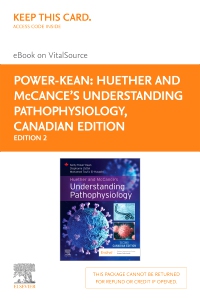
Huether and McCance's Understanding Pathophysiology, Canadian Edition - Elsevier EBook on VST (Retail Access Card), 2nd Edition
Elsevier eBook on VitalSource - Access Card

Now $86.39
**Textbook and Academic Authors Association (TAA) Textbook Excellence Award Winner, 2024**
Prepare for Canadian nursing practice with a solid understanding of pathophysiology and disease! Huether and McCance's Understanding Pathophysiology, 2nd Canadian Edition covers the basic concepts of pathophysiology and disease processes from a Canadian perspective. Clear descriptions and vibrant illustrations make it easier to understand body systems and the mechanisms of disease, and online resources bring pathophysiology concepts to life. Developed for Canadian nursing students by educators Kelly Power-Kean, Stephanie Zettel, and Mohamed Toufic El-Hussein, this text prepares students for success on the Next Generation NCLEX®, CPNRE®, and REx-PN™ and also in clinical practice.
-
- Introduction to Pathophysiology provides an entrance to the science of pathophysiology and explains why it is important.
- Lifespan coverage includes nine separate chapters on developmental alterations in pathophysiology and special sections with aging and pediatrics content.
- Canadian drug and treatment guidelines familiarize you with aspects of clinical practice you will encounter.
- Coverage of diseases includes their pathophysiology, clinical manifestations, and evaluation and treatment.
- Canadian lab values provide the core fundamental information required for practice in Canada.
- Canadian morbidity statistics provide you with the Canadian context in which you will be practising.
- Algorithms and flowcharts of diseases and disorders make it easy to follow the sequential progression of disease processes.
- Health Promotion boxes emphasize evidence-based care and align with the Canadian curriculum.
- Risk Factors boxes highlight important safety considerations associated with specific diseases.
- Quick Check boxes test your understanding of important chapter concepts.
- End-of-chapter Did You Understand? summaries make it easy to review the chapter’s major concepts.
- Key Terms are set in blue, boldface type and listed at the end of each chapter
- Glossary of approximately 1,000 terms is included on the Evolve website with definitions of important terminology.
-
- NEW! Updated content reflects current Canadian pathophysiology literature and evidence including incidence/prevalence, cultural variations, Canadian research and statistics, Canadian guidelines and standards, and Indigenous health.
- NEW! Easy-to-read writing style helps you understand and learn complex content.
- NEW! Case studies in each of the Alterations chapters provide the opportunity to use critical reasoning and clinical judgement to "pull it all together" and demonstrate application of knowledge.
- NEW! Comorbidities boxes in selected chapters link pathophysiology to pharmacology.
- NEW! Appendix of normal laboratory values in SI units is included for quick reference.
- NEW! More than 30 new 3-D animations are included on the Evolve website, bringing difficult concepts and disease processes to life.
- NEW! Test-preparation tools help you succeed on the Next Generation NCLEX®, CPNRE®, and REx-PN™ — both in the text and on Evolve!
-
PART ONE: BASIC CONCEPTS OF PATHOPHYSIOLOGY
Unit 1: The Cell
1. Cellular Biology
2. Genes and Genetic Diseases
3. Epigenetics and Disease
4. Altered Cellular and Tissue Biology
5. Fluids and Electrolytes, Acids and Bases
Unit 2: Mechanisms of Self-Defense
6. Innate Immunity: Inflammation and Wound Healing
7. Adaptive Immunity
8. Infection and Defects in Mechanisms of Defense
9. Stress and Disease
Unit 3: Cellular Proliferation: Cancer
10. Biology of Cancer
11. Cancer Epidemiology
12. Cancer in Children and Adolescents
PART TWO: BODY SYSTEMS AND DISEASES
Unit 4: The Neurologic System
13. Structure and Function of the Neurologic System
14. Pain, Temperature, Sleep, and Sensory Function
15. Alterations in Cognitive Systems, Cerebral Hemodynamics and Motor Function
16. Disorders of the Central and Peripheral Nervous Systems and Neuromuscular Junction
17. Alterations of Neurologic Function in Children
Unit 5: The Endocrine System
18. Mechanisms of Hormonal Regulation
19. Alterations of Hormonal Regulation
Unit 6: The Hematologic System
20. Structure and Function of the Hematologic System
21. Alterations in Hematologic Function
22. Alterations of Hematologic Function in Children
Unit 7: The Cardiovascular and Lymphatic Systems
23. Structure and Function of the Cardiovascular and Lymphatic Systems
24. Alterations of Cardiovascular Function
25. Alterations of Cardiovascular Function in Children
Unit 8: The Pulmonary System
26. Structure and Function of the Pulmonary System
27. Alterations of Pulmonary Function
28. Alterations of Pulmonary Function in Children
Unit 9: The Renal and Urologic Systems
29. Structure and Function of the Renal and Urologic Systems
30. Alterations of Renal and Urinary Tract Function
31. Alterations of Renal and Urinary Tract Function in Children
Unit 10: The Reproductive Systems
32. Structure and Function of the Reproductive Systems
33. Alterations of the Female Reproductive System
34. Alterations of the Male Reproductive System
Unit 11: The Digestive System
35. Structure and Function of the Digestive System
36. Alterations of Digestive Function
37. Alterations in Digestive Function in Children
Unit 12: The Musculoskeletal and Integumentary Systems
38. Structure and Function of the Musculoskeletal System
39. Alterations of Musculoskeletal Function
40. Alterations of Musculoskeletal Function in Children
41. Structure, Function, and Disorders of the Integument
42. Alterations of the Integument in Children
NEW! 43. Co-morbidity and Multi-morbidities (title and placement TBD)
Appendix:
NEW! Normal Laboratory Values
Index






 as described in our
as described in our 